
Marketing to Senior Australians? Here’s Why (And How) You Should
Let’s begin with some simple math:
According to the ABS, the current population of Australia is over 25 million. By 2020, 16.1% of the population is going to be 65 or older, which accounts for 4 million in total.
Senior citizens constitute a significant part of the consumer market. Yet marketing to seniors is often ignored by many Australian companies.
When it comes to marketing, businesses usually make younger customers their top priority. But it’s not sensible to ignore the big and growing number of senior citizens.
It’s not just about the number though. 65 to 74-year-olds have significantly more wealth than the rest of the age groups. This is not surprising as they’ve had a lifetime to achieve it. Moreover, according to AIWH, 13% of 65+ people are still in the workforce.
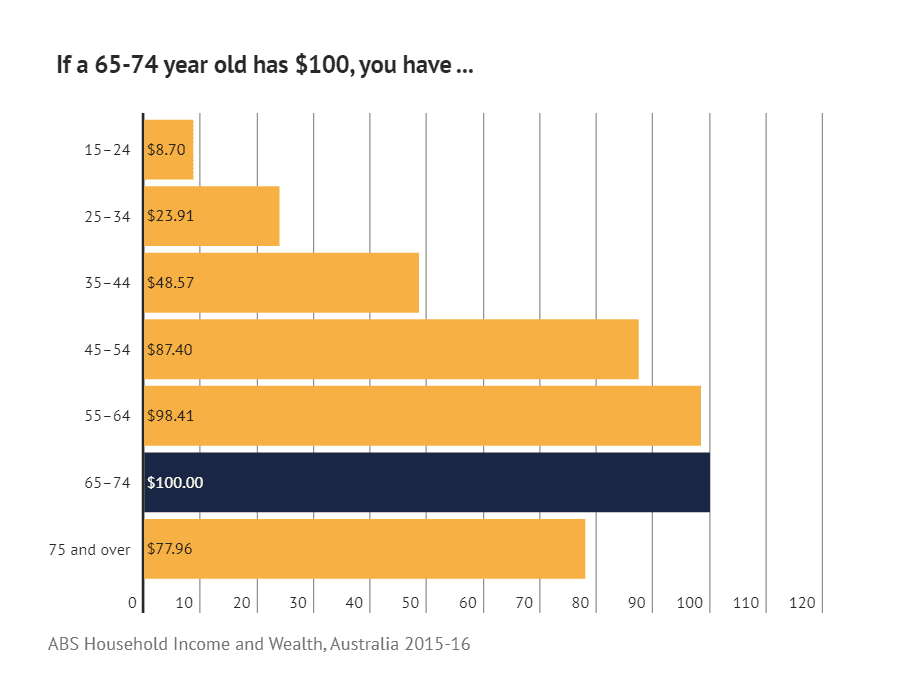
Baby boomers own more property than the other age groups. The homeownership rate among different age groups in Australia are given below: (2016 data)
- Age 65+: 82%
- 55 – 64: 78%
- 45 – 54: 72%
- 35 – 44: 62%
- 25 – 34: 44%
The DHS Annual Report (2018) shows that about 61% older adults in Australia receive a full-rate pension. The amount of total pension money received by the 65+ demographic per year was more than A$44.6 billion in 2017-18.
It’s obvious that senior Australians have more assets and higher discretionary income than the rest of the population. So, marketing to seniors is worth serious consideration for any business.
Why should you try marketing to seniors?
1. They have more purchasing power
On average, 65+ Australians have the means to spend significantly more than some other age brackets, particularly younger generations. They are free from work-related expenses, don’t need to spend money on their children, and usually have already paid off their mortgage.
According to the 2018 Financial Wellbeing report by RMIT and ANZ, older Australians have better financial stability than the rest of the population.

Senior citizens are not as old-fashioned as you may think. They are keen to catch up with the younger generation. In much the same way, they are after cars, clothes, and home renovations; have an interest in travelling, eating out and going to movies. They also are concerned about health and fitness.
Not to mention, they are nowadays spending on mobile phones, computers and other technological products.
2. They have a wide range of interest
Senior citizens are not as old-fashioned as you may think. They are keen to catch up with the younger generation. In much the same way, they are after cars, clothes, and home renovations; have an interest in travelling, eating out and going to movies. They also are concerned about health and fitness.
Not to mention, they are nowadays spending on mobile phones, computers and other technological products.
3. The senior demographic is growing
The number of people in the senior age group is projected to keep increasing in future. The chart below (from ABS data) shows how the proportion of 65+ people in the population will keep growing in the next decades.
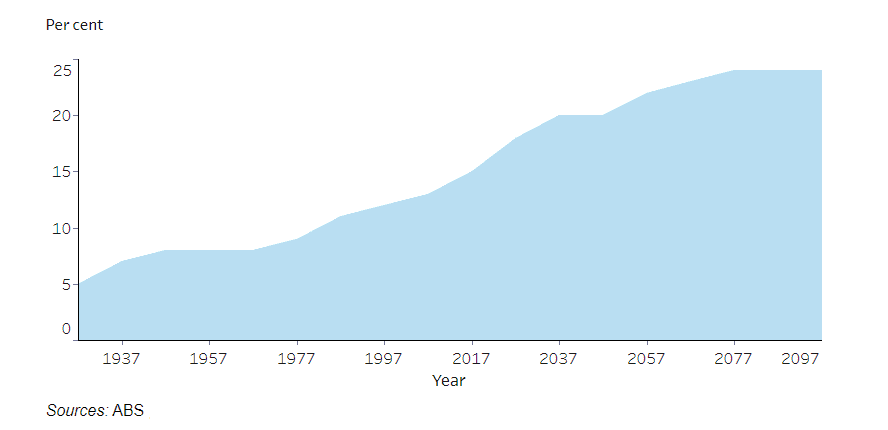
The life expectancy of older Australians is increasing. Australian men are now living longer than any other country in the world. Women are also doing well; they are currently ranked second, behind Switzerland.
How should you market to the senior citizens?
Marketing to seniors should be a lot more than using bigger fonts and images of older people. In fact, stereotyping seniors as old and helpless is the key mistake that marketers tend to make.
People have an entirely different attitude about aging these days. 65+ people don’t want to feel left out or be considered as backdated. So, your advertising should be more inclusive, upbeat and modern.
Here are a few points to keep in mind:
1. Know your potential customers
65+ Australians don’t view themselves as “older people”. They are interested in various products, including the ones targeted towards younger consumers. Gather data about your target group before you start marketing to seniors. You shouldn’t just assume what the senior customers want or what type of advertisements resonate with them.
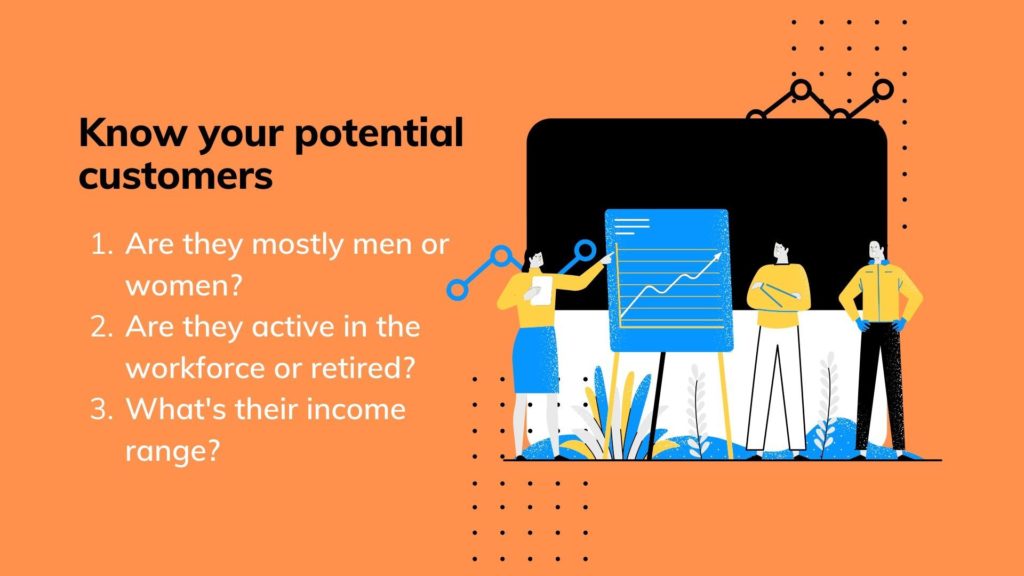
Commonwealth Bank’s retail report shows that most of the older Australians, especially men, think quality is more important than price. For older females, price is still a crucial factor in purchasing decisions. However, these behaviours may overlap and vary based on the type of product you are selling.
2. Make your ads inclusive and multigenerational
Multigenerational ads focus on both the older and younger customers. Here’s an example from Marcedes’s 2017 ad campaign:
There’s a practical reason why Mercedes chose to focus on both an aging boomer and his millennial son. In the US, 88% of so-called “youth” cars are actually purchased by middle-aged people.
The situation is similar in Australia. Yet we often see advertisements for smartphones and sports cars, for instance, are targeted only towards the age group of 18 to 35. The marketing industry is so age-biased that only 4.7% ads in Australia feature old people.
3. Avoid stereotyping. Use an upbeat, modern tone instead
A recent RMIT/SBS report shows that older Australians feel ignored by most of the companies. Major brands seem to be obsessed with younger customers. And when they do focus on seniors, the ads often miss the mark.
For example, here’s a recent ad from the South Australia Tourism Commission. The ad features a solitary elderly man at various tourist spots of Adelaide. At the end of the ad, the man starts to cry, and a voiceover says – “Don’t feel sorry for old mate. It’s his own damn fault he didn’t visit Adelaide sooner.”
The ad campaign triggered an outcry in social media, where people criticised it for being patronising and unfunny.
On the other hand, here’s an excellent example from Nike. You don’t generally associate the brand Nike with older adults. But look how they found a way to associate themselves with the senior customers – by rejecting the stereotype.
4. Use a mix of advertising channels
Online purchasing is increasing at a higher rate among pre-boomers and baby-boomers than younger generations. But according to the Commonwealth Bank Retail Insights, only 7% of older Australians prefer to shop online.
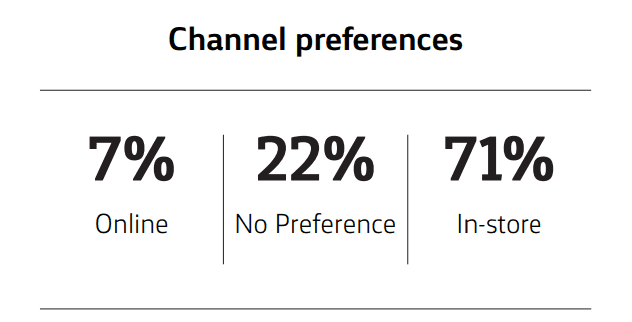
That doesn’t mean the convenience of online stores doesn’t attract senior customers. 51% of them research and compare prices before buying a product. One may start their purchasing journey on your ecommerce site and finally buy the product from your brick and mortar store.
When they buy products online, older customers have less expectation regarding the delivery service and store features compared to others.
To catch the senior market, you need to use a mix of online and offline marketing. This is also known as multichannel marketing.
In multichannel marketing, consistency is essential. 59% of baby boomers cited pricing consistency as an important factor affecting purchasing decisions. Unfortunately, 75% of Australian retailers don’t actively maintain consistent pricing across all marketing channels.
Here are some channels that you should consider for marketing to the seniors:
1. Email marketing:
Emails may be losing popularity among the Millenials, but it’s still prevalent among older generations. A 2018 survey shows 87% of Australians aged over 70 use email regularly.
2. Newspaper ads:
A recent report from Roy Morgan shows, 76.9% of Australians (of age 14+) read newspapers. This percentage is undoubtedly higher among the elderly population.
3. Television ads:
While most age groups are watching less and less broadcast TV, older people are watching more. 95% of them watch television. So, TV ads are a great way to reach older consumers.
4. Catalogue marketing:
Merchant catalogue still works for older consumers. Though it is considered old-fashioned by most people, many seniors find them useful for making purchasing decisions.
4. Online ads:
The 2015 data from Australian Communications and Media Authority shows 79% older (65+) Australians have accessed the internet. This was high compared to the US (58%) and the UK (56%).
According to a 2012 study by the AIMIA, people aged over 65 spent more than 3 hours per day browsing the internet and they were responsible for 20% of Australia’s total internet traffic. A more recent study has shown that the average time has reached 4 hours per day.
As more and more senior Australians are using the internet, online ads should be an essential part of your strategy in marketing to them.
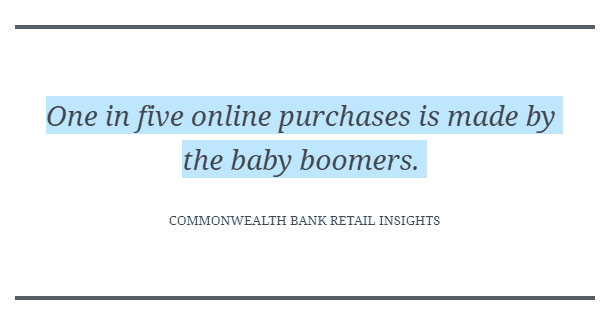
5. Social media marketing:
67% of 65+ Australians use social media (Yellow Social Media Report 2018). In fact, for 58% of these users, checking social media is the first thing they do in the morning.
Facebook is the most popular social media platform. On average, senior Australians are accessing Facebook 17 times a week. It may not be obvious, but social media marketing is an easy way to reach these people.
Most popular social media for 65+ Australians:
1. Facebook
2. YouTube
3. Pinterest
Tips for marketing to seniors through social media
1. Facebook ad is the best way to reach seniors:
There are over 1.2 million Facebook accounts in Australia that belong to people 65+ years old. Facebook lets you choose the target audience (age, location etc.) for your ads, so you can efficiently deliver advertisements to your intended customers.
Though the older generation doesn’t mind spending money on quality products, 49% of them are looking for discounts or give-aways when they follow you on social media. So, ads/posts with discount coupons or special offers are going to be more effective.
2. Interacting with your followers is very important:
Regularly replying to customer queries and having a steady flow of good reviews from real people are essential for earning the trust of older customers.
They love personalised replies and 13% of them use social media to follow their favourite brands. 74% will possibly change their opinion on a business/brand if the business responds well to bad reviews.
3. Focus on product features rather than viral campaigns:
16% of elders use social media to research products or services before buying. In contrast to the younger generations, this demographic doesn’t respond well to hypes. If you are marketing for 65+, focus on clear-cut ads that describe the usability of the product, not its “awesomeness”.
Top sectors for marketing to senior Australians in 2020
The chart below shows what 65 to 74-year-old Australian’s are spending their money on –
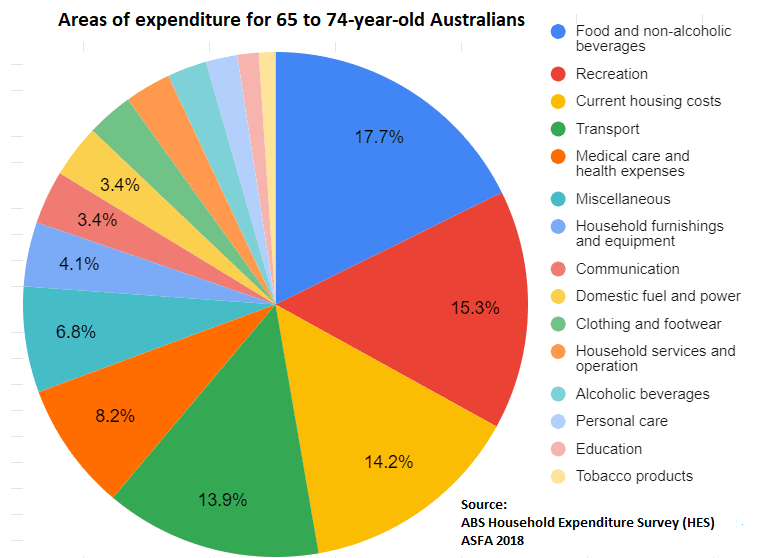
From this chart, it’s quite clear what the senior Australians are looking to buy. Here are the market sectors that are performing well with 65+ Australians –
1. Food and beverage
Older Australians are spending most (about 18%) of their money behind food and beverage. An additional 2.5% is spent on buying alcohol. Seniors don’t just buy food for themselves. Many (about 19%) of them do grocery shopping for their family.
Unfortunately, the food items targeting seniors feature unadventurous ingredients. These often, intentionally or unintentionally, remind older customers about their ailing health.
2. Recreation
Older people are more actively looking for recreational activity. For example, they are taking part in sports like golf. According to a 2019 report by SportAus, 19.7% of golf players are aged 65 or more.
3. Travelling
According to a study by Australian media company Macquarie, 39% of the total travel expenditure comes from people aged 55 to 69. From 2013 to 2018, the number of 65+ people travelling overseas has increased by more than 80%. Also, National Seniors reports that baby boomers usually take more extended vacations compared to other age groups.
4. Housing and real-state
Older Australians spend a significant amount (more than 20% of their income) in housing-related costs. Apart from real-state, they are interested in home renovation, furniture, household equipment etc.
5. Health and pharmaceuticals:
65 to 74-year-old Australians spends 8.2% of their money on medical care and health. They are more health-conscious than before. They also have a surprisingly well mental health condition. A 2019 Roy Morgan report shows that 79-year-olds have the best mental health compared to others.
High life expectancy and low birth rates have resulted in an ageing population in Australia. As Australia’s fertility rate falls to a record low, it’s clear that the older demographic will control a large portion of our economy going forward.
Under these new circumstances, the marketing strategy of companies – big or small – will invariably change, accounting for seniors who own a large percentage of the wealth in the country. Marketing to seniors presents both challenges and opportunities, but businesses can no longer ignore the seniors.
You read a lot. We like that
Want to take your online business to the next level? Get the tips and insights that matter.

